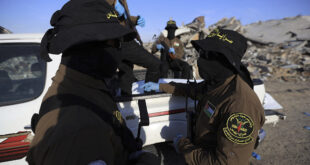(Reuters) – Rival Lebanese leaders reached a deal on Wednesday to end 18 months of political conflict that had pushed their country to the brink of a new civil war.
Here is a chronology of Lebanon in the last 18 months.
November 11, 2006 – Five pro-Syrian Shi’ite Muslim ministers from Hezbollah and its ally, the Amal movement, resign after the collapse of talks on giving their camp more say in government.
November 21 – Industry Minister Pierre Gemayel is killed.
December 1 – Hezbollah, Amal and supporters of Christian leader Michel Aoun camp outside Prime Minister Fouad Siniora’s office in Beirut in open-ended campaign to topple the government.
June 13, 2007 – Anti-Syrian parliamentarian Walid Eido and five other people killed by a car bomb near a Beirut beach club.
September 2 – Lebanese troops seize complete control of Nahr al-Bared camp after months of fighting with Fatah al-Islam militants which kills over 420 people, including 168 soldiers.
September 19 – Car bomb in Beirut kills anti-Syrian Christian lawmaker Antoine Ghanem and six other people.
November 23 – Lahoud leaves presidential palace at end of his term, no successor has been elected. Next day Siniora says his cabinet is assuming executive powers.
December 5 – Speaker Berri says rival Lebanese leaders have agreed on General Michel Suleiman as president.
December 12 – Car bomb kills Brigadier General Francois al-Hajj, the army’s head of operations, and a bodyguard in a Christian town east of Beirut.
January 15, 2008 – Car bomb in Christian area of Beirut kills at least 3 people and wounds 16, damages a U.S. embassy car and destroys others.
January 25 – Wisam Eid, a captain in a Lebanese police intelligence unit, is killed by a bomb blast in mainly Christian east Beirut. At least five other people are killed.
February 11 – Three army officers and 16 soldiers are charged over the killing of seven opposition protesters on January 27.
February 14 – Lebanon’s Hezbollah holds mass funeral for its assassinated commander Imad Moughniyah, in Beirut. He was killed in a bomb blast in Syria the day before.
May 6 – Hezbollah infuriated by government allegations it spied on Beirut airport and by cabinet’s decision to fire the head of airport security who is close to the opposition.
May 7 – Some 10 people are wounded as government supporters clash with gunmen loyal to the Hezbollah-led opposition in Beirut after followers of Hezbollah paralyse the capital.
May 8 – Hezbollah leader Sayyed Hassan Nasrallah says the government has declared war against the group after its decision to dismantle the group’s communication network.
May 9 – Hezbollah takes control of the Muslim half of Beirut.
May 10 – Hezbollah fighters pull back from areas they had seized in Beirut after the army — regarded as a neutral player — overturned government measures against the group.
May 11 – Hezbollah-led forces overrun posts held by gunmen loyal to Druze leader, Walid Jumblatt, in the Aley district east of Beirut before he agrees to hand them over to the army.
May 12 – Clashes resume in Tripoli in fighting which has killed 81 people since May 7.
May 14 – Lebanon cancels measures which sparked the fighting.
May 15 – An Arab League delegation brokers a deal which will end the fighting, political sources said. The deal is to include the lifting of a Hezbollah-led blockade on Beirut’s sea and airports and ending an armed presence in the streets.
May 16 – Talks to end the crisis open in Qatar.
May 20 – Arab mediators give Lebanon’s Hezbollah-led opposition a deadline to respond to proposals aimed at resolving the crisis.
May 21 – Rival leaders reach a deal to end the conflict.
 Eurasia Press & News
Eurasia Press & News



